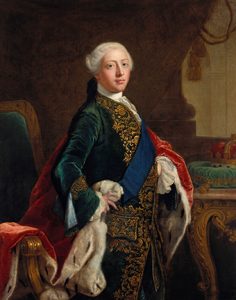
PHOTO: history.com
Last time on History’s Nutcases, we covered the remarkable Zhengde Emperor. This time, we’ll be pointing out another peculiar monarch in history, one who lived worlds away from Zhu Houzhao. King George III is, perhaps, best remembered for the taxes he put onto the American Colonies that sparked the signing of the Declaration and the American War for Independence. Later accounts, however, tell us that this famous monarch, as he got older, began to go mad. The exact reason for this is unknown, there’s several theories floating about. What we do know is that King George III lost his mind and became so incapacitated that his son had to take over his rule a full decade before George III’s death. Was he poisoned? Did the doctors have something to do with it? Was it a genetic disease, or simply an explainable pall that drove this famous monarch mad?
First, a little background. George III grew up a shy child, was overseen by many personal tutors, and ascended the English throne in 1760, while married to Lady Sarah Lennox. Remarkably, he never took a mistress, and he and his wife had a whopping fifteen children. King George III was Monarch of Great Britain during the Seven Years’ War between France and England. He lived during Napoleonic France, and was king of England during the famous American Revolution and the Industrial Revolution. He was a supporter of Prime Minister William Pitt, and during Pitt’s ministry, George III was very popular in England. But, as the years wore on, something began to go terribly wrong.
By 1765, just five years after George III had taking on the monarchy, he suffered a bout of terrible illness. It didn’t last very long, but his health was never the same. Almost two decades later, it was clear the king was starting to lose his mind. At the end of the parliamentary session, he was sent 100 miles away from London to the Cheltenham Spa to recuperate, but his condition drastically worsened. He would talk to nobody in particular for house without pause, sometimes so quickly that he would start to foam at the mouth and lose his voice. Claims began to spin around England, claims about how the King shook hands with a tree, thinking it was the King of Prussia. He had whole conversations with his ancestors and angels he believed were waiting for him in heaven. At many points, King George III thought he was already dead. He would have violent outbursts, forcing others to restrain him for his own safety. Most curiously, the King would be mad for a few weeks, and then have sudden bouts of sanity. King George knew he was losing his mind, and he often confided in his son that he hoped he would die before he went completely insane.

PHOTO: bostonteapartyship.com
By 1810, at the height of his popularity, King George III was completely blind. In the wake of the death of his youngest and favorite daughter, Princess Amelia, the stress nearly killed him. The Prince of Wales had to act as Regent for the last leg of the King’s life. By the end of 1811, King George had lost his mind completely, and he lived alone at Windsor Castle until his death. His wife died in 1818, and the story goes that on Christmas Day, one year later in 1819, King George spoke complete and utter nonsense for 58 hours straight, and lost his ability to walk in the last month of his life. He died at Windsor Castle, at 8:38 PM, on January 29, 1820.
So, what happened, really? How could a man who led such a normal early life become so devastatingly mentally ill in the last leg of it? Why did he have moments of perfect lucidity? It’s a mystery that’s baffled historians for centuries. His own doctors didn’t exactly know what was wrong with him.
Most people have put it down to psychosis, but a later theory emerged in the 1970s when two psychiatrists, Ida MacAlpine and her son Richard Hunter were looking through the King’s medical records and noticed a startling symptom: dark red urine. Dark red urine is an unmistakable sign of the blood disorder porphyria.
Now, most of King George’s symptoms match up with the disease. But the trouble was that usually males who have the disorder don’t suffer from acute porphyria at all, and what’s more, King George III didn’t suffer any attacks until his 50s.
The final piece of the puzzle comes down to the King’s doctors. In 2003, a scrap of paper containing a few strands of King George III’s hair was found in the vaults of a London Museum. These few hairs ended up being the last clue to why King George III lost his mind. The hair was tested by the Harwell International Business Centre for Science & Technology, and what the scientists found was staggering. The king’s hair contained over three-hundred times the level of arsenic needed to kill a man. According to Professor Tim Cox, an expert on extreme cases of porphyria, the disease can stay buried in a person’s genetics their entire lives. But certain substances, like alcohol or even monthly hormones can turn the disorder into a deadly disease. Arsenic is listed as one of the major triggers of porphyria.

PHOTO: dailymail.co.uk
Where on earth did the King get so much arsenic? Well, according to King George III’s medical reports from his doctors, he was being prescribed a medication called antimony. According to a 19th century almanac, antimony, even purified antimony contains massive levels of arsenic. King George’s medication prescribed to control his “madness” was the exact thing causing his madness in the first place. His attacks were brought on by a lifetime of arsenic being stored up in his body to dangerous levels, and his illness was prolonged by the medication used to treat him.
So there it is, the mystery of King George III’s madness is, for now, settled until more evidence comes to light. I can’t imagine what it must have been like, to, in the later years of life, start to lose my mind. I can’t imagine the utter fear going through George’s mind as he knew he was going insane. It is, perhaps, one of the most heartbreaking cases of insanity in history, mostly because his madness was completely avoidable.


